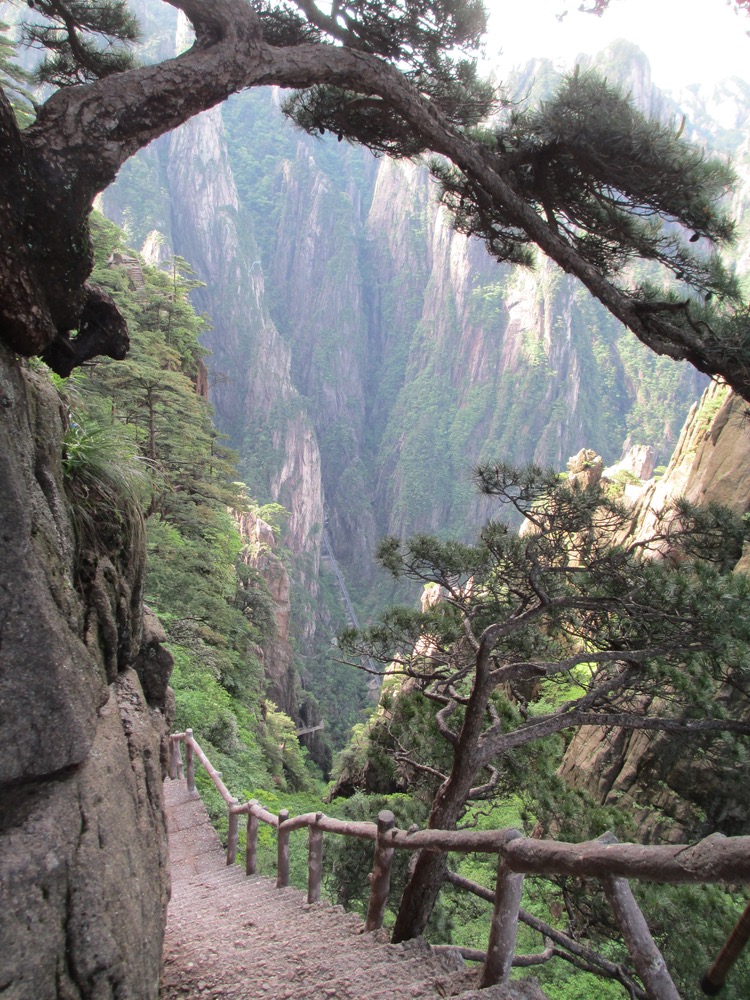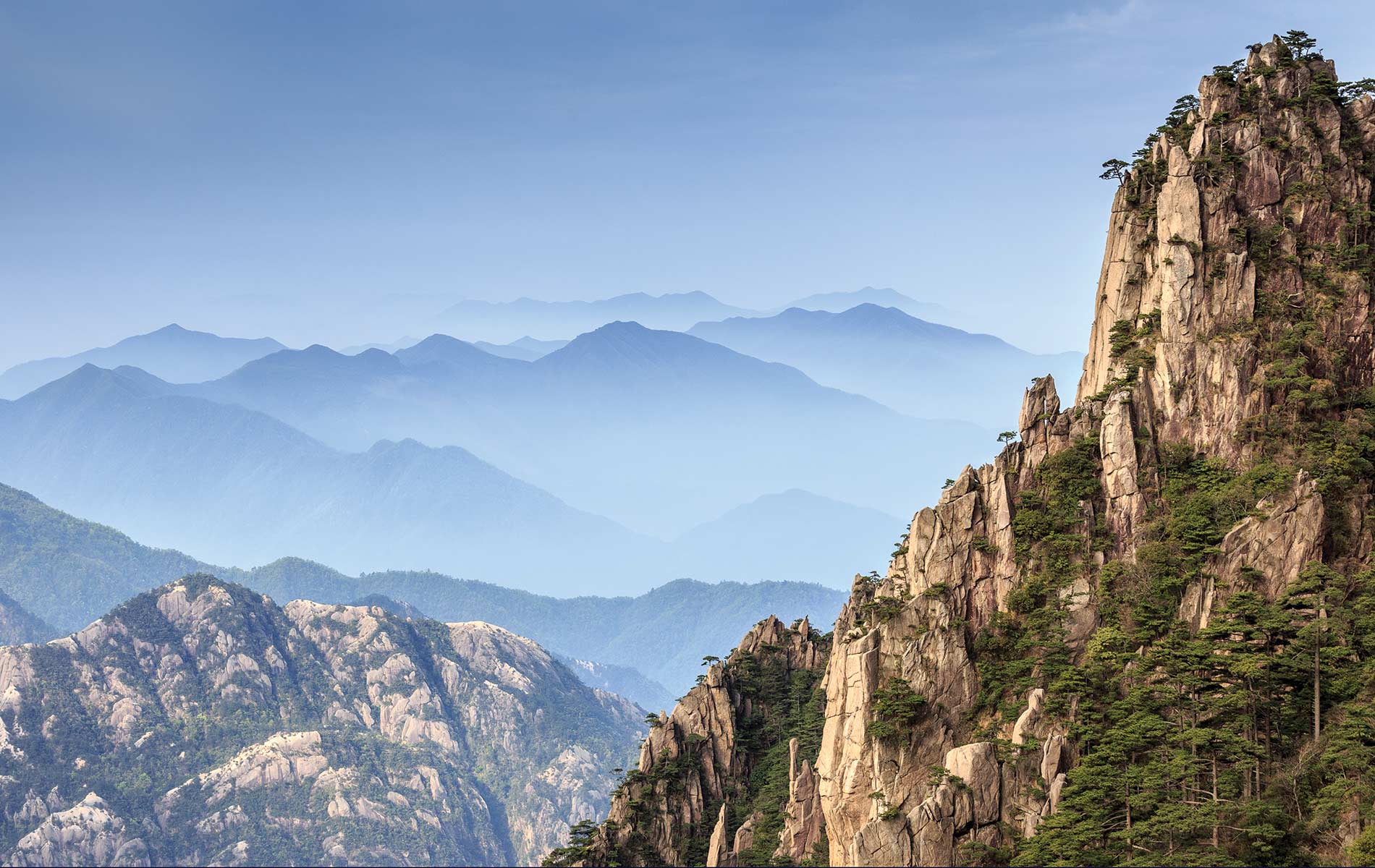
vie-magazine-china
Postcards from China
The Huangshan Mountains
Story and photography by Dale Foster
How many times have you noticed the mountainscape paintings in your local Chinese restaurant? They seem to be idealized depictions of some fairy-tale place. Not so. Located approximately 250 miles (396 kilometers) west of Shanghai, the Huangshan Mountains are very real and magnificent, and they have inspired artists and poets for over thirteen centuries.
Mount Huangshan (Yellow Mountain) has been described as the “loveliest mountain of China.” Its history is shrouded in mysticism and folklore. One eighth-century Tang Dynasty legend claimed the mountain contained the elixir of immortality. During the sixteenth-century Ming Dynasty, the marvelous views of the granite peaks emerging from a sea of clouds inspired the Shanshui (“mountain and water”) school of landscape painting.
The Huangshan Mountains are a popular tourist destination for Chinese travelers and a UNESCO World Heritage site, yet they are hardly known by Americans. The mountains reach over 6,100 feet (1,860 meters) in height and are protected by the Huangshan National Park. Due to the ever-changing panorama of clouds, mountains, and pines, it is one of the most beautiful and intriguing sites in the world.
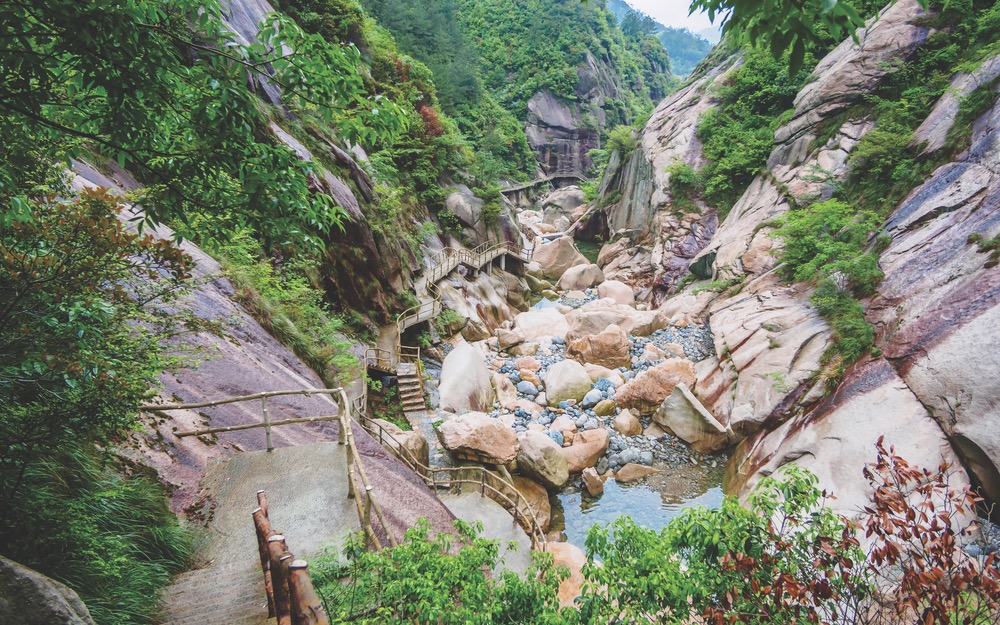
Rocky peaks, tree-lined ridges, and rhododendron-filled valleys are complemented by oddly shaped boulders, rugged gorges, caves, tunnels, waterfalls, lakes, and hot springs. It is the Huangshan pine that gives this mountain range its special look. Predominantly evergreen, the Huangshan pine lives at altitudes above 2,600 feet (800 meters). What gives this species of tree its unique beauty is that the bark of the trunk and branches is also dark green, highlighting the effect of the green pine needles. Accented against the backdrop of tannish granite, the green pines are a unique and pleasing view that evokes feelings of tranquility and relaxation. Some of the trees are extremely old, unusually shaped, and celebrated by the Chinese, especially the illustrious Welcome Tree (sometimes referred to as the Guest-Greeting Pine).
The scenery is breathtaking. Thanks to the constant movement of clouds funneling through the valleys and over the mountain peaks, it is a continually changing vista. From higher elevations, clouds can be seen climbing vertically from the lower valleys, giving a perspective that people in many parts of the world will never see. The weather patterns change quickly. A beautiful, clear, and sunny window can quickly close with clouds for long periods of time and then, just as suddenly, clear again. Each moment in the Huangshan Mountains is truly a unique experience, so bring a camera and stay alert! The angle of the sun, the cloud cover, the vegetation, and the shadows are never exactly the same.
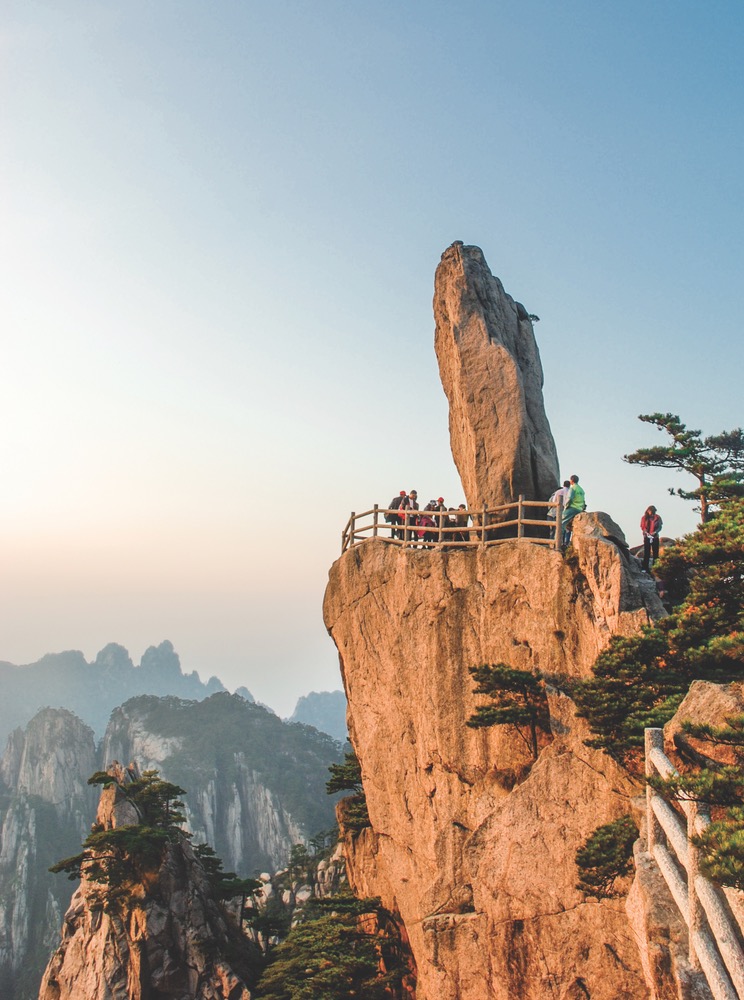
The scenery is breathtaking. Thanks to the constant movement of clouds funneling through the valleys and over the mountain peaks, it is a continually changing vista.
To enjoy all the splendor the mountains have to offer requires a good deal of walking. It has been said that there are sixty thousand steps in the park. I think this is a gross underestimation. The paths are in good condition, with footsteps formed from local rocks or carved into the mountain granite. Still, the steps are almost vertical at times, creating a challenge whether one is hiking up or down the mountains. The park’s designers did an admirable job of blending paths with the natural habitat so as not to be eyesores. For example, most of the guardrails have been fabricated to resemble tree branches.
Along the paths, one occasionally sees Chinese calligraphy chiseled into or painted on large rock slabs. These precipice inscriptions are historical records of Mount Huangshan and have become an integral part of the mountain’s heritage. The remains of ancient Buddhist temples can also be seen along the way, augmenting the cultural legacy of the area.
Adding to the allure of the park are the names of peaks and lookouts. Beginning to Believe Peak, Monkey Watching Sea of Clouds, Immortal Peak, Turtle Carrying Gold Peak, Heavenly Dog Watching the Moon, and Zhu Bajie (a greedy pig from a Chinese folktale) Eating the Watermelon are just a few.
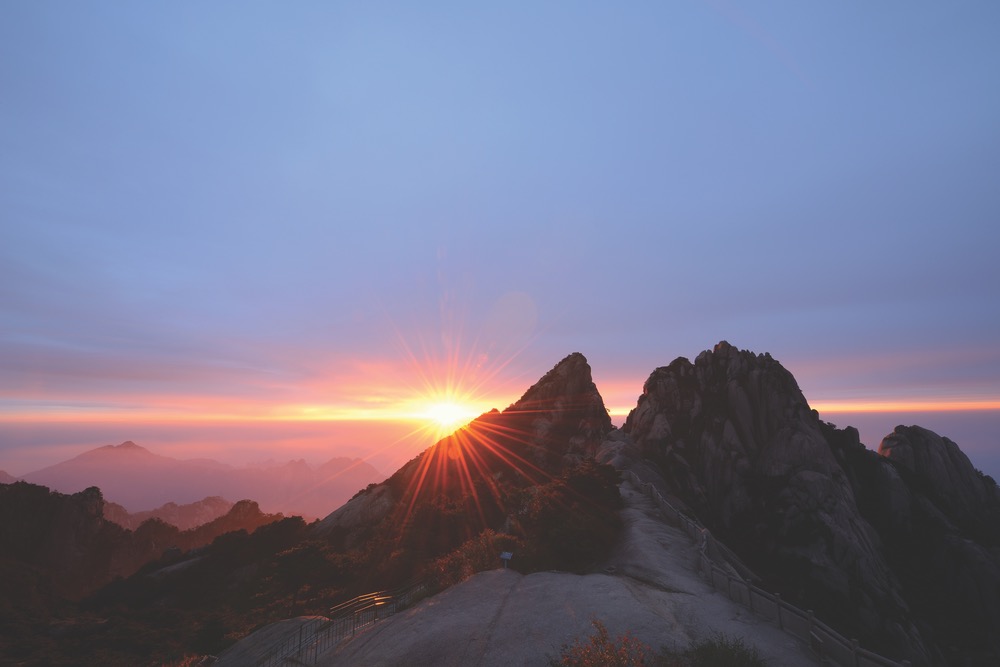
One of the best places to watch the sun set is the Cloud Dispelling Pavilion. The west-facing platform overlooks a picturesque valley and splendid, tree-lined mountain peaks with names such as Upside-Down Boot, Shoes Being Dried, and Wu Song (a legendary Chinese hero) Fighting the Tiger. Here the mist and clouds gather and part, allowing viewers colorful glimpses of the setting sun. Padlocks engraved with couples’ names line the guardrails, accentuating the romanticism of this spot.
For a lucky few, a chance occurrence of “Buddha’s light” can be seen from the mountain peaks. This optical phenomenon resembles a colorful halo and can be seen when the observer is between the sun and a cloud of refracting water droplets.
Sunrise at the east-facing Red Cloud Peak is also a spectacle. With flashlights in hand, hikers jostle for the best viewing spot to see the sun’s glow over the enchanting peaks before it is enveloped in a sea of clouds. It is a scene that is both peaceful and exhilarating.
For the adventurous—and physically fit—the West Sea Grand Canyon (also called Xihai Grand Canyon) is one of the must-see parts of Mount Huangshan Park. Starting near the Cloud Dispelling Pavilion, hikers are treated to a view of one of the most beautiful valleys in the world. Every turn is a new scene, a new angle, a new perspective, and a new feeling of awe. Speckled in with the pines are occasional flowering plants whose colors are magnified by the backdrop of pines, granite, and sky. The steps are sometimes steep and precarious, with walkways suspended high above the canyon floor without vertical supports. Hikers get the sensation they are floating above the clouds as they walk to the Illusion Scenic Area, where they can view Immortal Walking on Stilts Peak or Above the Clouds Peak.
On this trail, hikers reach the park’s highest point, Lotus Peak, at 6,115 feet.
On this trail, hikers reach the park’s highest point, Lotus Peak, at 6,115 feet (1,864 meters). From there it is a long downhill walk to the Mercy Light Station, where it is possible to catch a bus back to town. Along the way, hikers are treated to stunning views of distant summits, imposing peaks, narrow tunnels, and scenic bridges. The hiking here is challenging; porters gather at times to take exhausted hikers down the steep slopes on bamboo chairs. Impressively, the porters also carry luggage, food, and water up these same steps. All provisions are delivered to the park hotels in this manner—no motorized vehicles are allowed.
Due to its remoteness in China’s Anhui province, Huangshan Mountain National Park is a bit difficult to reach. Most foreign visitors travel from Shanghai by airplane or train to Huangshan City, which is about 275 miles (442 kilometers) from the park. From there, a taxi is the most reliable way to get to the park’s entrance or nearby hotels. The Cheng Jin Hotel, located in West Tangkou Town, is convenient to the park bus terminal and has a friendly, helpful staff and a good restaurant for local Anhui cuisine. For those wanting to stay inside the park, there are a handful of options. The Beihai and Paiyunlou hotels offer hostel-style lodgings on top of the mountain, while the Xihai Hotel offers more luxurious accommodations and elegant dining.
Whether staying in town or in the mountain hotels, the regional Anhui food and famous Huangshan Mao Feng tea are essential parts of the Huangshan Mountain experience. Anhui cuisine uses fresh local produce, herbs, and fish. Most of the ingredients, such as stone frogs, mushrooms, bayberry, tea leaves, and bamboo shoots, come from the mountain areas.
Mount Huangshan Park is one of the most renowned scenic landscapes in China, with estimates of over two million people visiting each year. To avoid crowds, try to catch the early buses from the park entrance to the Yungu Temple cableway station. Be prepared for at least an hour-long wait to board the cableway that takes visitors up the steep slopes to the higher elevations, where the scenery is the best. The gondola ride offers the first samples of the majestic scenery to follow.
Once on top of the mountain, tour groups huddle together while their guides blare away on megaphones. Independent hikers are left to explore the park on their own. It is humorous that the tourist maps and even the path-side placards are so inaccurate. Some peaks and overlooks are often labeled different names (Red Cloud Peak and Purple Cloud Peak are the same site), and the routes give no indication of real direction or elevation changes. These challenges aside, the park is well laid out and worth the effort. The longer and more difficult paths offer smaller crowds, though one is seldom alone for very long given the popularity of the park.
Mount Huangshan Park is a scenic delicacy that is meant to be savored, so it takes at least three days to enjoy all it has to offer.

Mount Huangshan Park is a scenic delicacy that is meant to be savored, so it takes at least three days to enjoy all it has to offer. Given the ever-changing weather patterns, you can never be sure when rain and clouds might blow in. The park is said to average 258 foggy days per year. The mountains are over a mile above sea level, so it is a good idea to let your body acclimate to the thinner air before attempting long hikes.
The Huangshan Mountains can be visited and enjoyed any time of the year. Expect larger crowds on the weekends and on holidays. Our visit in May was pleasant, with some spring flowers still in bloom. Supposedly, winter is the best season to view the cloud sea. The weather is unpredictable, so rain gear is recommended and can be purchased in the local stores or at the park hotels.
It is easy to see why the Huangshan Mountains are among the iconic symbols of China and have been the subject of Chinese art for centuries. They are a source of national pride. Today, China’s growing middle class favors these mountains for experiencing the cultural wonder and natural beauty of their country. As China has become more open to foreign travelers in recent years, the rest of the world can now share the magnificence of the Huangshan Mountains, too.
— V —
Dale Foster is a Certified Beach Bum, inventor, adventurer, businessman, writer, television producer, and volunteer for worthwhile causes around the world. He has been a happy resident of Santa Rosa Beach, Florida, since 2005.
Share This Story!
KEEP UP WITH THE LATEST STORIES FROM VIE




